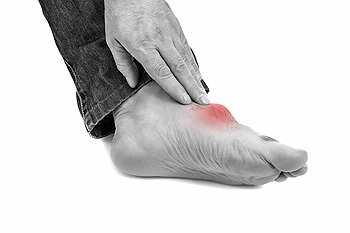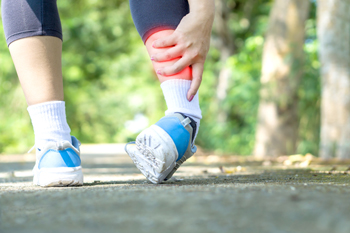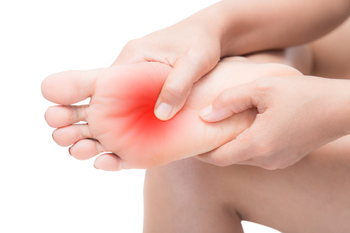Houston
Pearland
 Gout is a form of inflammatory arthritis that affects the big toe and can cause severe joint pain. Gout is three times more likely to affect men than women. A proper diagnosis will require a podiatrist to assess the foot and rule out other possible diagnoses. Upon a gout diagnosis, medications such as anti-inflammatory drugs or corticosteroids may be prescribed. However, the typical primary treatment method for gout involves reducing uric acid levels in the blood. While there are many prescriptions that may help reduce these levels, diet is key. Avoiding high purine foods, sugary drinks, and alcohol will help reduce uric acid levels. If you believe that you are suffering from gout, consult with a podiatrist for a proper diagnosis and treatment.
Gout is a form of inflammatory arthritis that affects the big toe and can cause severe joint pain. Gout is three times more likely to affect men than women. A proper diagnosis will require a podiatrist to assess the foot and rule out other possible diagnoses. Upon a gout diagnosis, medications such as anti-inflammatory drugs or corticosteroids may be prescribed. However, the typical primary treatment method for gout involves reducing uric acid levels in the blood. While there are many prescriptions that may help reduce these levels, diet is key. Avoiding high purine foods, sugary drinks, and alcohol will help reduce uric acid levels. If you believe that you are suffering from gout, consult with a podiatrist for a proper diagnosis and treatment.
Gout is a painful condition that can be treated. If you are seeking treatment, contact Dr. Linda D. Nachmani from Central Foot & Ankle Associates. Our doctor will treat your foot and ankle needs.
What Is Gout?
Gout is a form of arthritis that is characterized by sudden, severe attacks of pain, redness, and tenderness in the joints. The condition usually affects the joint at the base of the big toe. A gout attack can occur at any random time, such as the middle of the night while you are asleep.
Symptoms
Risk Factors
Prior to visiting your podiatrist to receive treatment for gout, there are a few things you should do beforehand. If you have gout you should write down your symptoms--including when they started and how often you experience them, important medical information you may have, and any questions you may have. Writing down these three things will help your podiatrist in assessing your specific situation so that he or she may provide the best route of treatment for you.
If you have any questions, please feel free to contact one of our offices located in Houston, and Pearland, TX. We offer the newest diagnostic and treatment technologies for all your foot care needs.
Read more about Everything You Need to Know About Gout Ankle sprains are a common injury among athletes. The severity of an ankle sprain can vary from a mild overstretching of the ligaments in the ankle to a severe ligament tear. While there are options for treating mild ankle sprains at home, such as resting, icing, compressing, and elevating the affected ankle, further medical attention will be warranted in more severe cases. You should seek immediate medical attention if your foot or lower leg is bent at an angle. You should also see a doctor if you heard a popping sound at the time of injury, have moderate to severe pain, have severe swelling or bruising, are unable to walk or bear weight on the affected ankle, experience numbness or tingling after the injury, or if you have swelling or bruising that lasts longer than two weeks. If you have any of these symptoms, it is suggested that you seek the care of a podiatrist as soon as possible.
Ankle sprains are a common injury among athletes. The severity of an ankle sprain can vary from a mild overstretching of the ligaments in the ankle to a severe ligament tear. While there are options for treating mild ankle sprains at home, such as resting, icing, compressing, and elevating the affected ankle, further medical attention will be warranted in more severe cases. You should seek immediate medical attention if your foot or lower leg is bent at an angle. You should also see a doctor if you heard a popping sound at the time of injury, have moderate to severe pain, have severe swelling or bruising, are unable to walk or bear weight on the affected ankle, experience numbness or tingling after the injury, or if you have swelling or bruising that lasts longer than two weeks. If you have any of these symptoms, it is suggested that you seek the care of a podiatrist as soon as possible.
Ankle sprains are common but need immediate attention. If you need your feet checked, contact Dr. Linda D. Nachmani from Central Foot & Ankle Associates. Our doctor can provide the care you need to keep you pain-free and on your feet.
How Does an Ankle Sprain Occur?
Ankle sprains take place when the ligaments in your ankle are torn or stretched beyond their limits. There are multiple ways that the ankle can become injured, including twisting or rolling over onto your ankle, putting undue stress on it, or causing trauma to the ankle itself.
What Are the Symptoms?
Preventing a Sprain
Treatment of a Sprain
Treatment of a sprain depends on the severity. Many times, people are told to rest and remain off their feet completely, while others are given an air cast. If the sprain is very severe, surgery may be required.
If you have suffered an ankle sprain previously, you may want to consider additional support such as a brace and regular exercises to strengthen the ankle.
If you have any questions please feel free to contact one of our offices located in Houston, and Pearland, TX. We offer the newest diagnostic and treatment technologies for all your foot and ankle needs.
Read more about Ankle Sprains The medical condition that is known as flat feet is noticeable while standing on the floor, and is generally caused by genetic factors. Some people can live with flat feet and have no issues or pain arise, but many athletes affected by this ailment can result in serious injury if not prepared for. The arch acts similar to shock absorbers, and can help in pushing off when walking and running. Patients who are afflicted with flat feet may feel pain and discomfort while participating in sporting activities, which may be caused by loose tendons. Additionally, these patients may have difficulty standing for extended periods of time, and may experience pain in other areas of the body, including the feet, knees, hips, and lower back. If you have flat feet, please consult with a podiatrist who can determine the right treatment for you.
The medical condition that is known as flat feet is noticeable while standing on the floor, and is generally caused by genetic factors. Some people can live with flat feet and have no issues or pain arise, but many athletes affected by this ailment can result in serious injury if not prepared for. The arch acts similar to shock absorbers, and can help in pushing off when walking and running. Patients who are afflicted with flat feet may feel pain and discomfort while participating in sporting activities, which may be caused by loose tendons. Additionally, these patients may have difficulty standing for extended periods of time, and may experience pain in other areas of the body, including the feet, knees, hips, and lower back. If you have flat feet, please consult with a podiatrist who can determine the right treatment for you.
Flatfoot is a condition many people suffer from. If you have flat feet, contact Dr. Linda D. Nachmani from Central Foot & Ankle Associates. Our doctor will treat your foot and ankle needs.
What Are Flat Feet?
Flatfoot is a condition in which the arch of the foot is depressed and the sole of the foot is almost completely in contact with the ground. About 20-30% of the population generally has flat feet because their arches never formed during growth.
Conditions & Problems:
Having flat feet makes it difficult to run or walk because of the stress placed on the ankles.
Alignment – The general alignment of your legs can be disrupted, because the ankles move inward which can cause major discomfort.
Knees – If you have complications with your knees, flat feet can be a contributor to arthritis in that area.
Symptoms
Treatment
If you are experiencing pain and stress on the foot you may weaken the posterior tibial tendon, which runs around the inside of the ankle.
If you have any questions please feel free to contact one of our offices located in Houston, and Pearland, TX. We offer the newest diagnostic and treatment technologies for all your foot and ankle needs.
Read more about What is Flexible Flat Foot? Falling is a common occurrence among the elder population. The feet can be affected and can negatively impact completing daily activities. There are several protective measures that can be implemented, ranging from getting regular physical examinations to reducing hazards that may be present in the home. These can include removing worn carpets from the stairs and living environment, improving household lighting, and installing grab bars in the shower and toilet area. Additionally, frequently performing simple stretches can help the body to become stronger, and this may help to prevent falling episodes. For more information about how falling can affect the feet, please consult with a podiatrist who can guide you toward proper prevention techniques.
Falling is a common occurrence among the elder population. The feet can be affected and can negatively impact completing daily activities. There are several protective measures that can be implemented, ranging from getting regular physical examinations to reducing hazards that may be present in the home. These can include removing worn carpets from the stairs and living environment, improving household lighting, and installing grab bars in the shower and toilet area. Additionally, frequently performing simple stretches can help the body to become stronger, and this may help to prevent falling episodes. For more information about how falling can affect the feet, please consult with a podiatrist who can guide you toward proper prevention techniques.
Preventing falls among the elderly is very important. If you are older and have fallen or fear that you are prone to falling, consult with Dr. Linda D. Nachmani from Central Foot & Ankle Associates. Our doctor will assess your condition and provide you with quality advice and care.
Every 11 seconds, an elderly American is being treated in an emergency room for a fall related injury. Falls are the leading cause of head and hip injuries for those 65 and older. Due to decreases in strength, balance, senses, and lack of awareness, elderly persons are very susceptible to falling. Thankfully, there are a number of things older persons can do to prevent falls.
How to Prevent Falls
Some effective methods that older persons can do to prevent falls include:
Falling can be a traumatic and embarrassing experience for elderly persons; this can make them less willing to leave the house, and less willing to talk to someone about their fears of falling. Doing such things, however, will increase the likelihood of tripping or losing one’s balance. Knowing the causes of falling and how to prevent them is the best way to mitigate the risk of serious injury.
If you have any questions, please feel free to contact one of our offices located in Houston, and Pearland, TX. We offer the newest diagnostic and treatment technologies for all your foot care needs.
Read more about Falls Prevention Peripheral neuropathy is the result of nerve damage occurring in the extremities such as the hands or feet. Neuropathy can be caused by issues such as diabetes, physical injuries, a viral infection, or as a side effect of certain medications. Common symptoms of neuropathy include a sense of numbness or tingling, burning or stabbing pain, a loss of balance, and muscle weakness in the feet. If you are experiencing these symptoms, it is suggested that you visit a podiatrist for a proper treatment and diagnosis, especially if you are at a higher risk due to preexisting conditions, such as diabetes. Treatment options may vary depending on the causes and symptoms of your neuropathy.
Peripheral neuropathy is the result of nerve damage occurring in the extremities such as the hands or feet. Neuropathy can be caused by issues such as diabetes, physical injuries, a viral infection, or as a side effect of certain medications. Common symptoms of neuropathy include a sense of numbness or tingling, burning or stabbing pain, a loss of balance, and muscle weakness in the feet. If you are experiencing these symptoms, it is suggested that you visit a podiatrist for a proper treatment and diagnosis, especially if you are at a higher risk due to preexisting conditions, such as diabetes. Treatment options may vary depending on the causes and symptoms of your neuropathy.
Neuropathy
Neuropathy can be a potentially serious condition, especially if it is left undiagnosed. If you have any concerns that you may be experiencing nerve loss in your feet, consult with Dr. Linda D. Nachmani from Central Foot & Ankle Associates. Our doctor will assess your condition and provide you with quality foot and ankle treatment for neuropathy.
What Is Neuropathy?
Neuropathy is a condition that leads to damage to the nerves in the body. Peripheral neuropathy, or neuropathy that affects your peripheral nervous system, usually occurs in the feet. Neuropathy can be triggered by a number of different causes. Such causes include diabetes, infections, cancers, disorders, and toxic substances.
Symptoms of Neuropathy Include:
Those with diabetes are at serious risk due to being unable to feel an ulcer on their feet. Diabetics usually also suffer from poor blood circulation. This can lead to the wound not healing, infections occurring, and the limb may have to be amputated.
Treatment
To treat neuropathy in the foot, podiatrists will first diagnose the cause of the neuropathy. Figuring out the underlying cause of the neuropathy will allow the podiatrist to prescribe the best treatment, whether it be caused by diabetes, toxic substance exposure, infection, etc. If the nerve has not died, then it’s possible that sensation may be able to return to the foot.
Pain medication may be issued for pain. Electrical nerve stimulation can be used to stimulate nerves. If the neuropathy is caused from pressure on the nerves, then surgery may be necessary.
If you have any questions, please feel free to contact one of our offices located in Houston, and Pearland, TX. We offer the newest diagnostic and treatment technologies for all your foot care needs.
Read more about Neuropathy